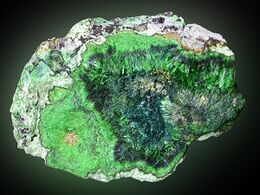Chemistry:Guilleminite
| Guilleminite | |
|---|---|
 A cuprosklodowskite vug filled with well formed dark green vandenbrandeite crystals. These are dusted over with small yellow crystals of guilleminite. | |
| General | |
| Category | Oxide minerals |
| Formula (repeating unit) | Ba(UO2)3(SeO3)2(OH)4·3H2O |
| Strunz classification | 4.JJ.10 |
| Dana classification | 34.07.03.01 |
| Crystal system | Orthorhombic |
| Crystal class | Pyramidal (mm2) (same H-M symbol) |
| Space group | P21nm |
| Unit cell | 869.48 Å3 |
| Identification | |
| Color | Bright yellow, greenish yellow, yellow |
| Cleavage | Perfect on {100}, good on {010} |
| Fracture | Brittle |
| Tenacity | Brittle |
| Mohs scale hardness | 2 |
| |re|er}} | Waxy, greasy, dull, earthy |
| Diaphaneity | Transculent |
| Specific gravity | 4.88 |
| Optical properties | Biaxial (−) |
| Refractive index | nα = 1.720 nβ = 1.798 nγ = 1.805 |
| Birefringence | 0.085 |
| Pleochroism | Strong |
| 2V angle | Measured 35°, calculated 32° |
| Dispersion | r > v strong |
| Other characteristics | |
| References | [1][2][3] |
Guilleminite (Ba(UO2)3(SeO3)2(OH)4·3H2O) is a uranium mineral named by R. Pierrot, J. Toussaint, and T. Verbeek in 1965 in honor of Jean Claude Guillemin (1923–1994), a chemist and mineralogist. It is a rare uranium/selenium mineral found at the Musonoi Mine in the Katanga Province of the Democratic Republic of the Congo.[2]
This secondary mineral also includes barium in its structure, in addition to selenium and uranium. It is bright yellow in colour and usually has an acicular crystal habit. It has a Mohs hardness of 2–3.[5]
Pleochroism
Guilleminite shows strong pleochroic attributes. Depending on the axis the gem is seen, guilleminite on the X axis can be seen in a bright yellow color, on the Y axis can be seen yellow, and on the Z axis is seen as a colorless gem.
References
- ↑ Mineralienatlas
- ↑ 2.0 2.1 Guilleminite: Guilleminite mineral information and data on Mindat.org
- ↑ Webmineral data
- ↑ Warr, L.N. (2021). "IMA–CNMNC approved mineral symbols". Mineralogical Magazine 85 (3): 291–320. doi:10.1180/mgm.2021.43. Bibcode: 2021MinM...85..291W.
- ↑ Pierrot R, Toussaint J, Verbeek T. Bull. Soc. Franc. Mineral. Crist. 1965; 88: 132.
 |

